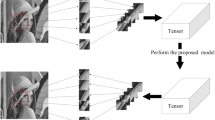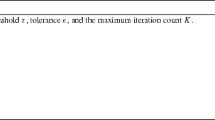Abstract
Videos received from certain sources may contain irrelevant contents which might reduce the amount of information conveyed by it. This paper proposes an effective tensor based video inpainting approach to improve the quality of these videos by removing and replacing unwanted contents with relevant information. The proposed method employs reweighted tensor decomposition technique to identify and discard the inappropriate sparse components of the video data. These sparse components are substituted with proper contents by utilising spatio-temporal consistency through reweighted tensor completion. The replacement is carried out in such a way that the resulting video possesses superior temporal consistency and visual credibility. The proposed method is applied to sparse text removal of videos having dynamic content in various extents and is found that our method outperforms its counterparts.














Similar content being viewed by others
References
Arizona State University, Yuv video sequences. http://trace.eas.asu.edu/yuv/
Baburaj M, George SN (2017) Twist tensor total variation regularized-reweighted nuclear norm based tensor completion for video missing area recovery, Information Sciences
Bornard R, Lecan E, Laborelli L, Chenot JH (2002) Missing data correction in still images and image sequences. In: Proceedings of the tenth ACM international conference on multimedia. ACM, pp 355–361
Boyd S, Parikh N, Chu E, Peleato B, Eckstein J (2011) Distributed optimization and statistical learning via the alternating direction method of multipliers. Found Trends Mach Learn 3(1):1–122
Boykov Y, Veksler O, Zabih R (2001) Fast approximate energy minimization via graph cuts. IEEE Trans Pattern Anal Mach Intell 23(11):1222–1239
Candes EJ, Wakin MB, Boyd SP (2008) Enhancing sparsity by reweighted 1 minimization. J Fourier Anal Appl 14(5):877–905
Carroll JD, Chang JJ (1970) Analysis of individual differences in multidimensional scaling via an n-way generalization of “eckart-young” decomposition. Psychometrika 35 (3):283–319
Choi JK, Dong B, Zhang X (2017) An edge driven wavelet frame model for image restoration. arXiv:170107158
Cichocki A, Mandic D, De Lathauwer L, Zhou G, Zhao Q, Caiafa C, Phan HA (2015) Tensor decompositions for signal processing applications: from two-way to multiway component analysis. IEEE Signal Proc Mag 32(2):145–163
Comon P (2014) Tensors: a brief introduction. IEEE Signal Proc Mag 31(3):44–53
Criminisi A, Perez P, Toyama K (2003) Object removal by exemplar-based inpainting. In: 2003. Proceedings. 2003 IEEE computer society conference on computer vision and pattern recognition. IEEE, vol 2, pp II–II
De Lathauwer L, De Moor B, Vandewalle J (2000) A multilinear singular value decomposition. SIAM J Matrix Anal Appl 21(4):1253–1278
De Lathauwer L (2009) A survey of tensor methods. In: 2009. ISCAS 2009. IEEE international symposium on circuits and systems. IEEE, pp 2773–2776
Demanet L, Song B, Chan T (2003) Image inpainting by correspondence maps: a deterministic approach. Appl Comput Math 1100(217-50):99
Ding T, Sznaier M, Camps OI (2007) A rank minimization approach to video inpainting. In: 2007. ICCV 2007. IEEE 11th international conference on computer vision. IEEE, pp 1–8
Drori I, Cohen-Or D, Yeshurun H (2003) Fragment-based image completion. In: ACM transactions on graphics (TOG). ACM, vol 22, pp 303–312
Ebdelli M, Le Meur O, Guillemot C (2015) Video inpainting with short-term windows: application to object removal and error concealment. IEEE Trans Image Process 24(10):3034–3047
Efros AA, Leung TK (1999) Texture synthesis by non-parametric sampling. In: 1999. The proceedings of the seventh IEEE international conference on computer vision. IEEE, vol 2, pp 1033–1038
Goldfarb D, Qin Z (2014) Robust low-rank tensor recovery: models and algorithms. SIAM J Matrix Anal Appl 35(1):225–253
Granados M, Tompkin J, Kim K, Grau O, Kautz J, Theobalt C (2012) How not to be seen—object removal from videos of crowded scenes. In: Computer graphics forum, Wiley online library, vol 31, pp 219–228
Grasedyck L, Kressner D, Tobler C (2013) A literature survey of low-rank tensor approximation techniques. GAMM-Mitteilungen 36(1):53–78
Guo Q, Zhang C, Zhang Y, Liu H (2016) An efficient svd-based method for image denoising. IEEE Trans Circ Syst Video Technol 26(5):868–880
He K, Sun J (2012) Statistics of patch offsets for image completion. In: Computer vision–ECCV 2012. Springer, pp 16–29
He W, Zhang H, Zhang L, Shen H (2016) Total-variation-regularized low-rank matrix factorization for hyperspectral image restoration. IEEE Trans Geosci Remote Sens 54(1):178–188
Hu W, Tao D, Zhang W, Xie y, Yang Y (2016) The twist tensor nuclear norm for video completion.. In: IEEE transactions on neural networks and learning systems
Ji H, Huang S, Shen Z, Xu Y (2011) Robust video restoration by joint sparse and low rank matrix approximation. SIAM J Imaging Sci 4(4):1122–1142
Jia J, Tang CK (2003) Image repairing: Robust image synthesis by adaptive nd tensor voting. In: 2003. Proceedings. 2003 IEEE computer society conference on computer vision and pattern recognition. IEEE, vol 1, pp I–I
Jia J, Tai YW, Wu TP, Tang CK (2006) Video repairing under variable illumination using cyclic motions. IEEE Trans Pattern Anal Mach Intell 28(5):832–839
Kilmer ME, Braman K, Hao N, Hoover RC (2013) Third-order tensors as operators on matrices: a theoretical and computational framework with applications in imaging. SIAM J Matrix Anal Appl 34(1):148–172
Kolda TG, Bader BW (2009) Tensor decompositions and applications. SIAM Rev 51(3):455–500
Komodakis N, Tziritas G (2007) Image completion using efficient belief propagation via priority scheduling and dynamic pruning. IEEE Trans Image Process 16(11):2649–2661
Kressner D, Steinlechner M, Vandereycken B (2014) Low-rank tensor completion by riemannian optimization. BIT Numer Math 54(2):447–468
Krishnamurthy A, Singh A (2013) Low-rank matrix and tensor completion via adaptive sampling. In: Advances in neural information processing systems, pp 836–844
Ling CH, Lin CW, Su CW, Chen YS, Liao HYM (2011) Virtual contour guided video object inpainting using posture mapping and retrieval. IEEE Trans Multimed 13(2):292–302
Liu Y, Caselles V (2013) Exemplar-based image inpainting using multiscale graph cuts. IEEE Trans Image Process 22(5):1699–1711
Lu C, Feng J, Chen Y, Liu W, Lin Z, Yan S (2016) Tensor robust principal component analysis: Exact recovery of corrupted low-rank tensors via convex optimization. In: Proceedings of the IEEE conference on computer vision and pattern recognition, pp 5249–5257
Martin CD, Shafer R, LaRue B (2013) An order-p tensor factorization with applications in imaging. SIAM J Sci Comput 35(1):A474–A490
Newson A, Almansa A, Fradet M, Gousseau Y, Pérez P (2014) Video inpainting of complex scenes. SIAM J Imaging Sci 7(4):1993–2019
Patwardhan KA, Sapiro G, Bertalmio M (2005) Video inpainting of occluding and occluded objects. In: 2005. ICIP 2005. IEEE international conference on image processing, vol 2. IEEE, pp II–69
Patwardhan KA, Sapiro G, Bertalmío M (2007) Video inpainting under constrained camera motion. IEEE Trans Image Process 16(2):545–553
Peng Y, Suo J, Dai Q, Xu W (2014) Reweighted low-rank matrix recovery and its application in image restoration. IEEE Trans Cybern 44(12):2418–2430
Pritch Y, Kav-Venaki E, Peleg S (2009) Shift-map image editing. In: 2009 IEEE 12th international conference on computer vision. IEEE, pp 151–158
Semerci O, Hao N, Kilmer ME, Miller EL (2014) Tensor-based formulation and nuclear norm regularization for multienergy computed tomography. IEEE Trans Image Process 23(4):1678–1693
Umeda Y, Arakawa K (2012) Removal of film scratches using exemplar-based inpainting with directional median filter. In: International symposium on communications and information technologies (ISCIT), 2012. IEEE, pp 6–11
Venkatesh MV, Cheung ScS, Zhao J (2009) Efficient object-based video inpainting. Pattern Recogn Lett 30(2):168–179
Wang Z, Bovik AC, Sheikh HR, Simoncelli EP (2004) Image quality assessment: from error visibility to structural similarity. IEEE Trans Image Process 13(4):600–612
Wexler Y, Shechtman E, Irani M (2004) Space-time video completion. In: 2004. CVPR 2004. Proceedings of the 2004 IEEE computer society conference on computer vision and pattern recognition. IEEE, vol 1, pp I–I
Xu Y, Hao R, Yin W, Su Z (2013) Parallel matrix factorization for low-rank tensor completion. arXiv:13121254
Yoo S, Park RH (2009) Red-eye detection and correction using inpainting in digital photographs. IEEE Trans Consum Electron 55(3):1006–1014
Zhang Z, Aeron S (2017) Exact tensor completion using t-svd. IEEE Trans Signal Process 65(6):1511–1526
Zhang Z, Ely G, Aeron S, Hao N, Kilmer M (2014) Novel methods for multilinear data completion and de-noising based on tensor-svd. In: Proceedings of the IEEE conference on computer vision and pattern recognition, pp 3842–3849
Zhou X, Yang C, Zhao H, Yu W (2015) Low-rank modeling and its applications in image analysis. ACM Comput Surv (CSUR) 47(2):36
Author information
Authors and Affiliations
Corresponding author
Additional information
Publisher’s Note
Springer Nature remains neutral with regard to jurisdictional claims in published maps and institutional affiliations.
Rights and permissions
About this article
Cite this article
M, B., George, S.N. Tensor based approach for inpainting of video containing sparse text. Multimed Tools Appl 78, 1805–1829 (2019). https://doi.org/10.1007/s11042-018-6251-7
Received:
Revised:
Accepted:
Published:
Issue Date:
DOI: https://doi.org/10.1007/s11042-018-6251-7




